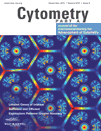
Experiment Overview
| Repository ID: | FR-FCM-Z667 | Experiment name: | Studying the impact of cell age on yeast growth behaviour of Saccharomyces pastorianus var. carlsbergensis by magnetic separation_anaerobic | MIFlowCyt score: | 82.50% |
| Primary researcher: | Marco Eigenfeld | PI/manager: | Marco Eigenfeld | Uploaded by: | Marco Eigenfeld |
| Experiment dates: | 2021-11-08 - 2022-08-27 | Dataset uploaded: | Apr 2023 | Last updated: | Apr 2023 |
| Keywords: | [budding yeast] [Yeast] [physiological state] | Manuscripts: | |||
| Organizations: |
Technische Universitaet Munich, Munich, (Germany)
|
||||
| Purpose: | Saccharomyces yeast is a very important and widely used microorganism for food production, biofuels and chemicals. Their viability and vitality depend on their age distribution and other environmental factors, especially concerning their fermentation performance. Therefore, we conducted this study to present an approach for separating aged brewers?yeast cells of Saccharomyces pastorianus sp. carlsbergensis, resulting in a yeast population with increased fermentation performance. We aimed to gain more detailed insights into the replicative age of heterogeneous yeast cultures and their impact on yeast viability. | ||||
| Conclusion: | In conclusion, our study showed that yeast cell age distribution and yeast cell viability have similar impacts on fermentation performance. The study results will help improve yeast fermentation performance and reproducibility in food industries. Furthermore, the production yield of biological products, like fatty acids or recombinant proteins, may be enhanced by fermentations with separated yeast populations. We believe this study's findings are relevant to your journal's scope and will interest its readership. | ||||
| Comments: | None | ||||
| Funding: | This work was supported by the Deutsche Forschungsgemeinschaft (DFG, German Research Foundation)–441672360 | ||||
| Quality control: | Before each measurement per day, QC beads were used to adjust the laser alignment. Each strain was measured in triplicate. | ||||
Experiment variables
| Conditions | |
|---|---|
| · Yeast | ICP_MS1.fcs · ICP_MS2.fcs · ICP_MS3.fcs · ICP_NS1.fcs · ICP_NS2.fcs · ICP_NS3.fcs · ICP_sup1.fcs · ICP_sup2.fcs · ICP_sup3.fcs · ICP_MS_r.fcs · ICP_NS_r.fcs · ICP_sup_r.fcs · Magsep 1.fcs · Magsep 2.fcs · Magsep 3.fcs · NS 1.fcs · NS 2.fcs · NS 3.fcs · Supernatent 1.fcs · Supernatent 2.fcs · Supernatent 3.fcs · Hefe 1.fcs · Hefe 2.fcs · Hefe 3.fcs |
| Sample Type | |
|---|---|
| · Inoculum | ICP_MS1.fcs · ICP_MS2.fcs · ICP_MS3.fcs · ICP_NS1.fcs · ICP_NS2.fcs · ICP_NS3.fcs · ICP_sup1.fcs · ICP_sup2.fcs · ICP_sup3.fcs · ICP_MS_r.fcs · ICP_NS_r.fcs · ICP_sup_r.fcs · Magsep 1.fcs · Magsep 2.fcs · Magsep 3.fcs · NS 1.fcs · NS 2.fcs · NS 3.fcs · Supernatent 1.fcs · Supernatent 2.fcs · Supernatent 3.fcs · NP.fcs · Hefe 1.fcs · Hefe 2.fcs · Hefe 3.fcs |
